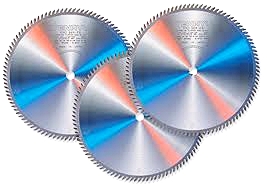Is it really necessary to buy a different blade for cutting different materials?
Saw blades can be a large investment, especially if they are a quality saw blade. It is often hard to bite the bullet and buy a new blade for a project because your cutting a different material or making a different type of cut, but it is worth it.
Different types of saws are designed specifically for the material, machine or the type of cut they are intended for. Different types of carbide grades and different tooth geometries are used depending on the type of cut and material being cut. Even hook angles differ based on the application. All of these things are taken into special consideration and designed to give you the best cut possible and also to help insure the operators safety during the cut for each specific material.
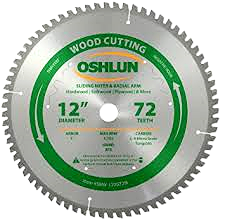 An Aluminum Cutting Saw Blade (or Non Ferrous Saw Blade) will typically have a TCG (Triple Chip Grind) and a negative hook angle. The triple chip grind has a lead tooth that has a double 45 degree angle corner bevel. This is followed by a flat topped raker tooth ground lower than the lead tooth. The raker tooth removes the corners left on both sides by the beveled lead tooth. Triple Chip Grinds combines a balanced cutting force, low tooth drag and free chip flow. This helps to eliminate chipping. The negative degree hook angle allows the blade to cut the material without grabbing into. A saw blade with a positive hook angle would be “bite” into the material more aggressively, which could potentially cause the blade to over feed or break the carbide tips on the blade.
An Aluminum Cutting Saw Blade (or Non Ferrous Saw Blade) will typically have a TCG (Triple Chip Grind) and a negative hook angle. The triple chip grind has a lead tooth that has a double 45 degree angle corner bevel. This is followed by a flat topped raker tooth ground lower than the lead tooth. The raker tooth removes the corners left on both sides by the beveled lead tooth. Triple Chip Grinds combines a balanced cutting force, low tooth drag and free chip flow. This helps to eliminate chipping. The negative degree hook angle allows the blade to cut the material without grabbing into. A saw blade with a positive hook angle would be “bite” into the material more aggressively, which could potentially cause the blade to over feed or break the carbide tips on the blade.
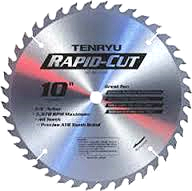 Many Melamine Cutting Saw Blades will have a Hi ATB grind and a negative hook angle. The High ATB grind has a steeper bevel than the standard ATB for chip-free cuts on Melamine and plastic laminate without the use of a scoring blade. The negative hook angle allows the material to be fed into the saw blade easier as opposed to a positive hook angle grabbing at the material. This helps prevent the material from chipping.
Many Melamine Cutting Saw Blades will have a Hi ATB grind and a negative hook angle. The High ATB grind has a steeper bevel than the standard ATB for chip-free cuts on Melamine and plastic laminate without the use of a scoring blade. The negative hook angle allows the material to be fed into the saw blade easier as opposed to a positive hook angle grabbing at the material. This helps prevent the material from chipping.
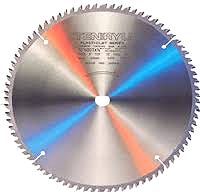 Most quality Plastic Cutting Saw Blades will use a special grade of carbide that will help with heat resistance to prevent the material from melting. They most commonly have an ATAF grind, which is great for more brittle materials like plastics and acrylic. With an ATAF grind the tips are ground on the top at an angle and also grind on the face at an angle. When combined into an ATAF (Alternate top –Alternate Face grind) you get a sharper cutting, more pointed edge.
Most quality Plastic Cutting Saw Blades will use a special grade of carbide that will help with heat resistance to prevent the material from melting. They most commonly have an ATAF grind, which is great for more brittle materials like plastics and acrylic. With an ATAF grind the tips are ground on the top at an angle and also grind on the face at an angle. When combined into an ATAF (Alternate top –Alternate Face grind) you get a sharper cutting, more pointed edge.
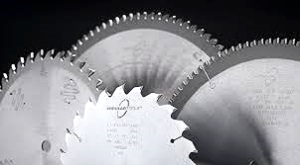 For cutting MDF, Plywood and particle board there are a few more options depending on whether blade life or cut quality is most important. Most Saw blades for Particle Board, MDF, or Plywood will have a positive hook angle to bite into the wood and allow you to feed faster. Which type of grind depends on the cut quality and blade life you want. MDF and particle board contain glue and filler which consists of small particles of cement. These particles and the glue wear down the tips on the blade very fast. Blades with a TCG grind don’t have quite as sharp as a point and will last much longer when cutting MDF or particle board, but will not give you the cleanest cut. For a cleaner cut, you could use a blade with an ATB grind. With an ATB grind the tops of alternating teeth are beveled to one side of the blade or the other at approximately 15 degrees. This creates a sharp point and a sharper cutting edge for better cut quality without chipping or splinters. It also caused the sharp tips to wear much faster.
For cutting MDF, Plywood and particle board there are a few more options depending on whether blade life or cut quality is most important. Most Saw blades for Particle Board, MDF, or Plywood will have a positive hook angle to bite into the wood and allow you to feed faster. Which type of grind depends on the cut quality and blade life you want. MDF and particle board contain glue and filler which consists of small particles of cement. These particles and the glue wear down the tips on the blade very fast. Blades with a TCG grind don’t have quite as sharp as a point and will last much longer when cutting MDF or particle board, but will not give you the cleanest cut. For a cleaner cut, you could use a blade with an ATB grind. With an ATB grind the tops of alternating teeth are beveled to one side of the blade or the other at approximately 15 degrees. This creates a sharp point and a sharper cutting edge for better cut quality without chipping or splinters. It also caused the sharp tips to wear much faster.
Leave a Reply



